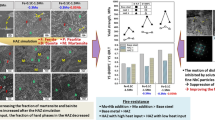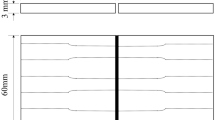Abstract
A fine-grained steel has the same components and weldability as a mild steel, whereas a conventional high-strength steel has lower weldability due to its alloying elements. The occurrence of softening caused by coarsening in the heat-affected zone (HAZ) of welded parts of the fine-grained steels and mechanical design of welded parts including weld HAZ-softening becomes much important. Mechanical properties of the HAZ-softening joint are examined by considering the characteristics of the tensile strength under the theory of the strength of undermatched joints. The effects of the mechanical and geometrical heterogeneity on tensile strength of the HAZ-softened joint are studied by using the large-deformation finite-element analysis. The design of the HAZ-softened joint is possible considering welding conditions and tensile strength of the joint that mostly overreach the strength of the base metal. The deformation behaviour and the fracture characteristics in HAZ-softened joints under the consideration of the actual use are furthermore investigated.
Similar content being viewed by others
References
Shiga C.: Progress in high strength steels with low temperature toughness for welded structures, Journal of Japan Welding Society (in Japanese), 1996, vol. 65, pp. 210–227.
Senuma T.: Physical metallurgy of modern high strength steel sheets, ISIJ International, 2001, vol. 41, pp. 520–532.
Torizuka S., Nagai K., Sato A.: State-of-the-art of creating 800 MPa class steel in STX-21 project, Journal of Japan Society for Technology of Plasticity (in Japanese), 2001, vol. 42, pp. 287–292.
Aihara S.: Present status and future prospect of the ferrous super metal project, Proceedings of the Fourth Symposium on Ultra-Steel (in Japanese), National Institute for Materials Science, Tsukuba, Japan, 2001, pp. 17–26.
Ito R., Kaneko N., Kawaguchi Y., Hiraoka K., Shiga C.: Characteristics of HAZ microstructures of ultra fine-grained steels for ultra narrow-gap GMA Welding, Proceedings of the Fifth Workshop on the Ultra-Steel (in Japanese), National Institute for Materials Science, Tsukuba, Japan, 2001, pp. 216–217s.
Satoh K., Toyoda M.: Effect of mechanical heterogeneity on the static tensile strength of welded joints, Journal of Japan Welding Society (in Japanese), 1971, vol. 40, No. 7, pp. 885–90.
Ohsawa Y., Nakano T., Ono Y., Suzuki I.: Evaluation of elasto-plastic behavior of soft welded joints for high strength steel pipe, NKK Technical Report (in Japanese), 1984, vol. 103, pp. 82–91.
Nitoh H., Sakai D., Yajima H., Inoue Y., Sogo Y., Satoh K., Toyoda M.: Tensile strength of welded joints for TMCP type 50kgf/mm2-Class high tensile steel plates, Journal of the Society of Naval Architects of Japan (in Japanese), 1985, vol. 157, pp. 304–311.
Matsumoto T., Satoh H., Kirihara S., Hataya F.: Investigations on static strength of undermatching welded joint of HT60 steel plates, Quarterly Journal of Japan Welding Society (in Japanese), 1986, vol. 4, pp. 429–435.
Yanagimoto J., Morimoto T., Kurahashi R., Chikushi I.: Mathematical modeling for rolling load and microstructure evolution in hot strip rolling, CAMP-ISIJ (in Japanese), 2001, vol. 14, pp. 325–328.
Kurahashi R., Chikushi I., Morimoto T., Yanagimoto J.: Microstructure control in tandem hot strip rolling with heavy reductions — A present situation and future development, CAMP-ISIJ (in Japanese), 2001, Vol. 14, pp. 1157–1160.
Qiu H., Kawaguchi Y., C. Shiga: Mechanical properties of the welded joints of ultra-fine grained steels, Proceedings of the Fifth Workshop on the Ultra-Steel (in Japanese), National Institute for Materials Science, Tsukuba, Japan, 2001, pp. 228–229.
Hibitt, Karlsson & Sorensen, Inc.: ABAQUS/Standard User’s Manual, Version 5.8, 1998, vols. 1 to 3.
Otsuka A., Miyata T., Nishimura S., Kimura M., Mabuchi M.: Effect of stress triaxiality on ductile fracture initiation of low strength steels, Journal of the Society of Materials Science, Japan (in Japanese), 1980, vol. 29, pp. 717–723.
Toyoda M., Ohata M., Yokota M., Yasuda O., Hirono M.: Criterion for ductile cracking for the evaluation of steel structure under large scale cyclic loading, Proceedings of the 20th International Conference on Offshore Mechanics and Arctic Engineering, OMAE01/MAT-3103, 2001.
Kuwamura H., Yamamoto K.: Criterion for ductile crack initiation in structural steels under triaxial stress state, Transactions of Architectural Institute of Japan, Journal of Structural and Construction Engineering (in Japanese), 1995, vol. 477, pp. 129–135.
McClintock F.A.: A criterion for ductile fracture by the growth of holes, Transactions of the American Society of Mechanical Engineers, Journal of Applied Mechanics, 1968, vol. 90, pp. 363–371.
Shimanuki H., Hagiwara Y.: Effect of stress triaxiality on ductile fracture initiation of steels — Ductile fracture initiation properties of steels (2nd Report), Preprints of National Meeting of Japan Welding Society (in Japanese), 1994, vol. 55, pp. 412–413.
Ishikawa N., Kobayashi Y., Kurihara M., Osawa K., Toyoda M.: Ductile crack initiation behavior of structural steel under cyclic loading, Tetsu-to-Hagane (in Japanese), 1999, vol. 85, pp. 71–77.
Mochizuki M., An G.B., Ohmura T., Toyoda M.: Strength and fracture in undermatched joint by dynamic loading — Studies on characteristics of dynamic deformation and fracture in welded joint with strength heterogeneity (Report 2), Quarterly Journal of Japan Welding Society (in Japanese), 2001, vol. 19, No. 3, pp. 547–555.
Toyoda M., Mochizuki M., An G.B., Ohmura T.: Characteristics of strength and fracture in undermatched welded joints by dynamic loading, Document for the 53rd Annual Assembly of the International Institute of Welding, Florence, Italy, 2000, IIW Doc. X-1459-2000 and IIW Doc. SC X-F-090–00.
Author information
Authors and Affiliations
Rights and permissions
About this article
Cite this article
Mochizuki, M., Shintomi, T., Hashimoto, Y. et al. Analytical Study on Deformation and Strength in HAZ-Softened Welded Joints of Fine-Grained Steels. Weld World 48, 2–12 (2004). https://doi.org/10.1007/BF03263396
Published:
Issue Date:
DOI: https://doi.org/10.1007/BF03263396




